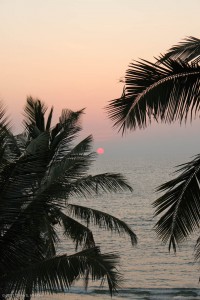
Kovalam Beach in Kerala "God's own country"
Remember how I said “I’ll write again from North India?” Yeah, so I sort of didn’t go back. It actually saved money to push the flight back and stay in the South longer, and who can argue with numbers? Truthfully, it has been really fascinating learning about the different culture and environment in the South…it also happens that it’s a tropical paradise. Coconuts are incredible healthy, as are pineapples, papayas…
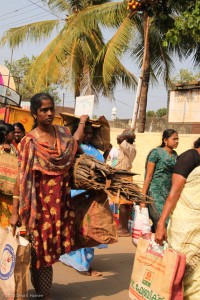
Women prepare for the Pangola Festival
I’ve been sightseeing in Thiruvananthapuram (no, I didn’t make that up, and everyone calls the city by its British name Trivandrum because isn’t that hard enough to say?) and on the 19th was the largest festival for women in all of Asia, honoring the goddess Bhaghvanthi. Women from all castes and ages all over India traveled to Trivandrum bringing coconut palms and making brick hearths where they could honor the goddess and then sleep the night. These hearths lined the streets of Trivandrum and were packed in one next to the other—another example of Indians’ lack of personal space issues. Men who were not residents of Trivandrum were not allowed in the city

Brick hearths where the women worship during the festival
limits for 24 hours! I have never seen so many women in one area. This festival was in the Guinness Book of World Records last year for the largest gathering of women in one place—over 2.5 million. I wonder if they broke the record this year.
Another favorite South India experience was the Trivandrum Zoological Gardens, first, because I love zoos, and second, because in America when we go to zoos most of what we are seeing is from places like India and Africa—somewhere very

The amazing cannonball tree!
far away—and it’s hard to imagine the animals in their native habitats. The zoo is located within a gated botanical gardens, so I saw fascinating plant and tree species too. My favorite was the cannonball tree which looks like something out of an enchanted forest. It’s covered in blossoms and a fruit that has the size and shape of a cannonball. The variety of birds were astonishing—the spoonbill was maybe the strangest, and then different types of

Spoonbill bird
storks, pelicans, and parrots I’ve never seen. Because of the diversity of India’s climate and landscapes, the most diverse range of species is found here. For instance, one-seventh of the more then 9,000 species of birds in the world are found in India alone.
Today I am going on a backwater tour, which the Lonely Planet Guide to India says is the number one thing you should do when traveling to the state of Kerala. I think it will be a beautiful and intriguing way to spend my last day in South India. The backwaters are a labyrinth of waterways through small islands and forests of palm trees. I’m hoping to learn more about the wildlife here and see more of it too!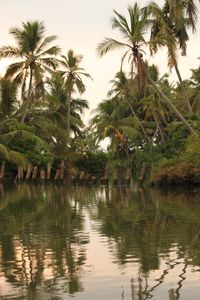
On the 23rd I will return to the U.S. and “normal” life, about which I have very mixed feelings. India has been challenging on an emotional, physical, and spiritual level, but has also been incredibly rewarding, fulfilling, and educational. I think I am stronger in every way with a more holistic perspective after these couple of months. One of my proudest moments came here in South India amidst some bartering that went down over a pair of trousers. The shopkeeper told me, “Don’t be like an Indian.” I don’t think I could have received a higher compliment. What followed was my victory in paying a reasonable price—about half of what he originally quoted to me as a “very cheap price.” I was also able to accomplish what I felt was some good writing—the play that takes place in Varanasi—but also, being removed and living more simply has enriched my other writings too. There were times I wished I could be at home in a comfy bed with a western toilet, without bugs in my room, and eating familiar foods; but now that that moment is so close, I feel I’m not ready to leave. I find myself already planning what I want to do/ how I want to prepare for my next Indian adventure. Something about being in the complex, but spiritual land of India makes my soul feel at home. I may be leaving India, but I am carrying a piece of her with me along with all my memories and all I have learned.
February 13, 2011
The Simple Life
Yikes! I know you, my avid readers, have been waiting with bated breath for some word on my blog, and to both of you I say: I’ve been having a blast! If only that were meant singularly in the colloquial sense and not as a defining characteristic of my bodily functions. Yes, I’ve been sick. But for the most part still functional. There’s a lot to catch you up on. And a lot more that you don’t need to hear.
Ashrams. The highlight of my trip. After nearly a month in Varanasi—which I have incidentally come to learn has a reputation even among Indians as being “a very intense place.” I’ve had this query a lot: “Why did you stay in Varanasi so long?” I’ve come to answer: “To prepare me for the rest of the trip!” Nothing has been quite as sensory overloading and exhausting as Varanasi, though India is India is India (from my white girl point of view). I did accomplish a lot of work at the apartment I stayed at in Varanasi, which is where one of the largest and most respected universities in India is located: Banares Hindu University. I made good headway on my play which takes place in Varanasi and learned more about Indian theatre. The central character is a young female street performer. Also was able to do some much-needed re-writes on other plays. I had a flat in a family home. It was pretty clean except for the mice. And I’ve come to adore squat toilets, particularly in the explosive state I have come to frequent India. But that’s the category of stuff you don’t need to hear, and I was talking about ashrams…

Meditation gardens and meditation temple at the YSS ashram in Ranchi (founded by Paramahansa Yogananda)
So onto the sacred, meditative, sanctuaries: the ashrams where I stayed. Ok, did you see that? That shift in subject and tone? That is SO India! I have been here long enough that I am embodying India herself. Seriously: Poop, then sacred. That dichotomy where you think, “Why is she talking about something disgusting and something beautiful in the same blog entry?” Similarly, in India you travel by train where you pay extra for A/C and assigned seats but see more cockroaches than you ever have in your life—even more than those shady, funky apartments in East L.A. you lived in. You wind through alleyways where it’s nearly impossible to not step in a cow pie and there’s a dead dog with flies and some dude is peeing on a wall. All this for a destination of white marble, serene meditation gardens: total peace. (I’m going back to the first
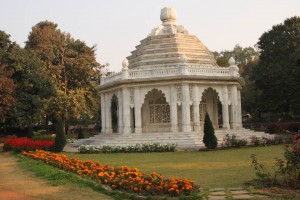
White marble mandir (temple) in Ranchi dedicated to my guru
person now since this is obviously about me.) You can see one ashram mandir (temple) on the right. I’m thinking, “India, you are a mystery to me.” The most beautiful, ornate, holy places. Even women in the lowest castes dress in gorgeous, bright-colored saris while they sweep, tend to their pigs, their goats, fetch water from the well.
I have to tell you, it fascinates me. But what’s changed in these last few weeks is that I no longer analyze its mystery in search of a code. I no longer feel like I’m standing on the outside from American eyes looking into this strange, indigenous, exotic land. I have never really appreciated Western literature about the East for the simple reason that too often it never goes beyond that point; and maybe they never sought to. I just think when you go into someone else’s land, you are taking something from them; you sought a different experience, or you sought out a yoga teacher, or you think you going there is part of your “saving the world,” whatever it may be. Of course, you can offer your American money, but you can also offer something more: a sacrifice of self. In Sanskrit this is referred to as Yagya. “Everything in the universe is a sacrificial interaction as it were of receiving and giving, taking in and letting out…Yagya is not simply sacrifice in the rudimentary or outer sense, but the way of transformation inherent in every movement of life, in which all things become interrelated and unified” (Yogini Shambhavi). This give and take, cause and effect is really the nature of the universe and the way we can evolve as humans. We must sacrifice the little self that thinks it has all the answers and is perturbed when others do things differently. The little self that thinks, “Ew. How can people live in such unsanitary conditions?” or “If I see one more person unload their snot like a loogie on the street, I am going to vomit.”
I have always tried to actively be open-minded, understanding, compassionate. But this trip has taught me that at 26 years of age, I had already managed to become very set in my ways and uptight in many ways. It’s hard to say whether I’ve missed normal digestion or a soft mattress more, but I didn’t know I was so attached to either of them because I took my cushy American life for granted. (When I say cushy, that refers to being American, as I am currently unemployed with a ton of debt. Still. Cushy.) I am soaking all these lessons in and will try to not carelessly fall back into old habits of thinking with strong preferences and impatience. If I do fall back into it, I’m going to make sure I travel.
Ashram Time and South India
The ashrams I have stayed at are Yogoda Satsanga Society, which is the India affiliate of my spiritual discipline, Self-Realization Fellowship founded by Paramahansa Yogananda, author of Autobiography of a Yogi, in 1920. An ashram is not any ashram. They can be as different as a Catholic cathedral and a
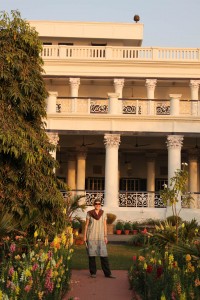
me in front of the temple and main building at the Dakshineswar ashram
Methodist church. I stayed about a week in Ranchi, a wooded, more mild-climate part if India, halfway between Varanasi and Kolkata. It was gated and huge and absolutely heavenly. I wrote, studied, meditated. Obviously, there is no internet in any ashrams which contributes to my infrequent posts. My schedule was like this:
6am: wake up
7:15am: energization exercises (part of my spiritual practice) and meditation
8am: breakfast
8:30am: spiritual study, writing, napping, meditation
12:30pm: lunch
1pm: more study, writing, napping, meditation
4pm: chai
5:30pm: energization exercises and meditation
8pm: dinner
10pm: bed
It was amazing! Totally rejuvenating and fulfilling and simple and sweet and peaceful. It was similar in Dakshineswar—another YSS ashram I stayed outside of Kolkata. From Kolkata I flew to Kerala “God’s Country,” a state in the southern-most part of India. While Kerala was greatly affected by the Tsunami in 2006, it is also known as the most socially advanced state in India. The literacy rate is 91% and the childbirth fatality rate is one-fifth less than the rest of the country. However, due to insufficient industry and opportunity, it also has the highest suicide rate in all of India. Kerala is much cleaner, hotter, and coconut-filled than the rest of India. I am here now and seriously feel like I’m in some movie in the tropics, or maybe a play…maybe I could call it Anna in the Tropics. Amma, known as the Hugging Saint all over the world, who has literally hugged millions, has several ashrams in Kerala.
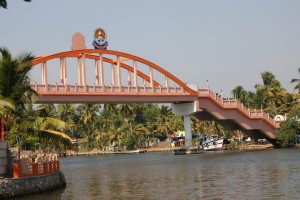
Amma's ashram has her own bridge...
Her main “ashram” is north of the city Kollam. That was a very interesting experience. Thousands of people live there, as renunciants. They all wear white (and many have white skin). I say “ashram” because it’s more of a compound, really. And there is constant chanting. I love the idea of Amma and she seems so sweet and full of love, but the organization feels kind of like it’s commercialized spirituality. You
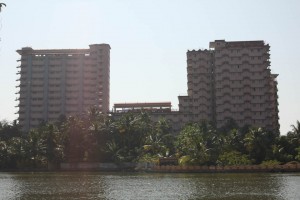
Resident housing at Amma's "ashram"!
can wear something with Amma’s picture on every inch of your body including a ring watch. Anyway, to each his own, but it couldn’t have been a more different experience than the other ashrams (Yogoda Satsanga Society) I stayed at previously.
So, I think you are pretty well caught up! I started this trip freezing my booty off and now I’m in the tropics! From here I fly back to Delhi, then trains to Jaipur “The Pink City” in Rajasthan where there are many beautiful palaces to see; Agra to see the Taj Mahal; Brindaban/Mathura where Krishna was born and grew up; and back to Delhi for a flight to SFO! I’ll write again when I’m up north.
January 17, 2011
Seeing the Dalai Lama
About 12 kilometers from Varanasi is the city of Sarnath, a pilgrimage spot for Buddhists (which I’m not; I know a little). But I’m a proponent of meditation, Eastern religions, and really any path that helps one to be a good/ better person/ kind to others. Sarnath is the site of a major archeological museum and is one of the 4 holy sites on the Buddha trail in Northern India.
This photo is from Deer Park, an archeological site from 7th century of a monastic community at the spot where the Buddha gave his first sermon. You might say it’s a “hot spot” for Buddists. And this week was a Buddhist conference at the Central Institute of Higher Tibetan Studies in Sarnath. You’ve never seen so many Buddhist monks and nuns. At least I haven’t. How did I find out about the Dalai Lama speaking in Sarnath, you ask? Facebook. Me and the D.L. are FB buddies. Yup…ok fine, I “Like” him. The photo to the right and below is from the talk I was at. (Photo credit to Tenzin Choejor/OHHDL.)

- The Dalai Lama in Sarnath. I was sitting to his right maybe 100 feet away.
The security is tight–like crossing a border almost. But I got in and got to hear the Dalai Lama speak (in Tibetan) to a crowd of thousands on the topic of avoiding the pitfalls in meditation. I only knew what it was about (sort of) because I bought an AM/FM radio with headphones from a street vendor for 200 rupees (about $4.50) and tuned in to the English translation channel. I’m pretty sure it was the first time I’ve heard a talk live in translation. The talk followed the Sutras pretty closely. Everyone had their sacred texts with them and acted like they’d done this a million times. It sort of made me feel like an ignorant American, looking around like “uhhh, huh?” There were no seats–just sitting on the ground. People brought their mats and cushions–like a picnic. I’ll be ready next time, but WOW what an awesome experience! Thanks, Facebook.
January 16, 2011
How Different?
“Namaste.” Did you know Varanasi is a major hippie destination? Well, I didn’t know the extent of it until I got here. Varanasi makes me feel very un-hippie (unlike Boston) because all the non-Indians seem to be dirty and barefoot with dreads, buying weed from a medical shop. Sounds kinda like California, right? Yeah…it’s not. And it shouldn’t be, of course. Maybe I will try to upload the SOUNDS of this city because you wouldn’t believe it. Between cows mooing, goats bleating (is that what you call what goats do?), dogs barking, incessant horns honking in a variety of pitches and durations, tires screeching, bicycle bells chiming, bells ringing, men and women singing, chanting, children laughing, babies crying, the pumping of a well, drilling, hammering, and other construction noises all simultaneously, falling asleep is a skill required that harkens back to dorm room days when I got stuck in the party dorm sophomore year.
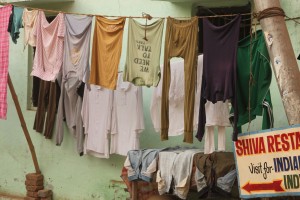
- Varanasi hippie laundry
Oh, and Indians don’t sleep as much–who would want to on a table bed, I guess. 6 hours is a full night’s sleep? That’s pretty much their maximum. And how do they eat spicy food at 10pm? Are our bodies so different, or did I just grow up accustomed to being a pampered American? I hate saying “them” and “us.” Feels very ignorant and dividing. But I guess part of that is the problematic limits of language. My overwhelming strong held belief is that we are all the same in essence if we took the time and opened our minds and hearts to “others” and why and how they do what they do. The problem is we don’t take that step. “We are all one” sounds like the Varanasi hippies or some abstract New Agey philosophy, I know. But, for one thing, it’s actually ancient–Hindu. And it has to be the direction where our consciousness evolves to or else how can we co-exist on this planet? Of course, I see borders, colors, differences, “us” and “them.” Let’s face it, there is no such thing as color blindness. So what’s the answer? Celebrate differences while being all-inclusive? What does it mean to “find oneself” anyway? It’s meaningless unless it’s expansive in some way–including new “different,” even scary, impossible, confusing, paradoxical–no, especially paradoxical views. If we don’t contradict ourselves, we aren’t learning enough, challenging ourselves enough.
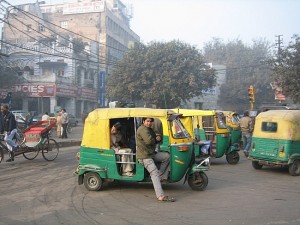
- Rickshaw, madam? Where go, madam?
Part of what’s good being here is the constant awareness of “otherness”–I don’t mean others’ otherness, I mean MY otherness. There is no escaping it. Between stares there is the incessant “Rickshaw, madam?” “Yes, please, madam. Yes, come.” “Madam, yes, buy.” “Money, madam.” “Food, madam.” There is no casual stroll down the street here. Why should there be? It’s invaluable for white people to go somewhere where they are treated differently, where they cannot relax around strangers. With my time here (now a few weeks) in otherness, I am not arriving at any big answers, but rather am daily filled with more and more questions.
January 12, 2011
I arrived in Varanasi on Thursday evening at a nice guesthouse with delicious home cooked Indian food and I was sick by Saturday. And because it’s cold, I’ve spent most of my time under the covers. But today I feel like, you know, I’ve had my Western share of quality time with the toilet and I’m ready to go out there and explore Varanasi, get to know this place. I made it to the Anandamayee Ma ashram…sort of. I THINK they told me “Come back Monday at 4,” but then they may have been saying something about where to leave my shoes…either way, the place was closed. I didn’t know ashrams close like shops? 
In my state of illness, just the scent of Indian food put me over the edge, so I found this little sanctuary (I bring my new security blanket from Etihad Airlines. I can’t begin to explain the value of a clean, soft blanket here…). The sanctuary is called Open Hand Cafe and they serve coffee. I just ate a veggie quiche and a brownie with French Press coffee and I’m surrounded by what every American needs to feel at home–fixed price merchandise. I’m slightly depressed by the discovery of just how American I really am. More soon.
January 7, 2011
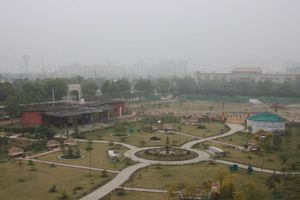 I departed on December 29 and thought, “haha suckers! I’m skipping winter!” I packed linen pants, skirts, etc. The anticipated weather for Varanasi at this time was 70s. Perfect. Not too hot; not too cold. So I arrive in Delhi and it’s about 40 degrees and nowhere has heating. I mean NOWHERE. Only A/C in India. I know this doesn’t sound cold to East Coasters. But when it’s colder INSIDE than outside and you’re sleeping on a table with a little bit of padding and there are open vents bringing in outside air…I mean, I pretty much feel hard core. Ok, well I did steal an Etihad Airlines blanket because it was fleece and brown and I thought maybe I’d need it…and that has seriously been a saving grace. And if you can ever fly Etihad, woah, you should. The UAE knows what’s up. Serious luxury.
I departed on December 29 and thought, “haha suckers! I’m skipping winter!” I packed linen pants, skirts, etc. The anticipated weather for Varanasi at this time was 70s. Perfect. Not too hot; not too cold. So I arrive in Delhi and it’s about 40 degrees and nowhere has heating. I mean NOWHERE. Only A/C in India. I know this doesn’t sound cold to East Coasters. But when it’s colder INSIDE than outside and you’re sleeping on a table with a little bit of padding and there are open vents bringing in outside air…I mean, I pretty much feel hard core. Ok, well I did steal an Etihad Airlines blanket because it was fleece and brown and I thought maybe I’d need it…and that has seriously been a saving grace. And if you can ever fly Etihad, woah, you should. The UAE knows what’s up. Serious luxury.
To contrast, I headed for the Yogoda Satsanga Ashram in Noida (outside of Delhi) via taxi, for which I overpaid double, I find out later. There’s a photo of the ashram and me in front of the main entrance. Every day I’m learning many lessons…like how to walk around without getting hit by a bicycle rickshaw, auto rickshaw, motorcycle, cow, wagon, water buffalo AND not stepping in cow pies. Oh, it’s an art. Thankfully, the ashram was an oasis from that. Very peaceful and the people couldn’t be sweeter. Meditation definitely helps deal with the chaos outside, especially as I’m still adjusting.
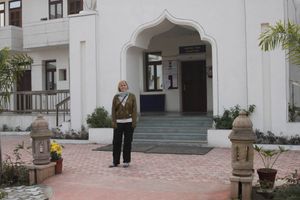
I have to keep this quick because my adapter doesn’t seem to be working to charge my laptop, and I’m working on a 5-year old iBook G4 here so…as my friend Natalie says, “that’s very hipster of you.” The good news is, internet seems to be working…sort of…so I can get back on it when I figure out a charging solution, or can find an internet cafe. Until then…
April 28, 2010
I am thrilled to be venturing to the Ganges River and one of the holiest cities in India – Varanasi (or Banaras), for about three months. Last semester I began writing a play set in this very city, which centers largely around an imaginative twelve-year-old girl who labors in a factory and has contracted the AIDS virus unknowingly through nursing from her inflicted mother. Her story is a harrowing one, but it is just one of millions of similar cases. It is my desire to offer a voice to such silenced individuals that fuels me to write plays. Thus, I will venture to India and conduct research on Indian children and communities afflicted with AIDS; I will volunteer at such organizations such as Sanjeevani Booti, which aims to educate Northern India on AIDS and other blood borne illnesses. I will stay in both local ashrams and hotels, and though I will be conducting research, will try to immerse myself in the Indian culture. I cannot wait to set foot in the sacred temples and mosques, visit beautiful museums, observe the ornate performance art, and delve into the rich history and culture that make up this fascinating country!
